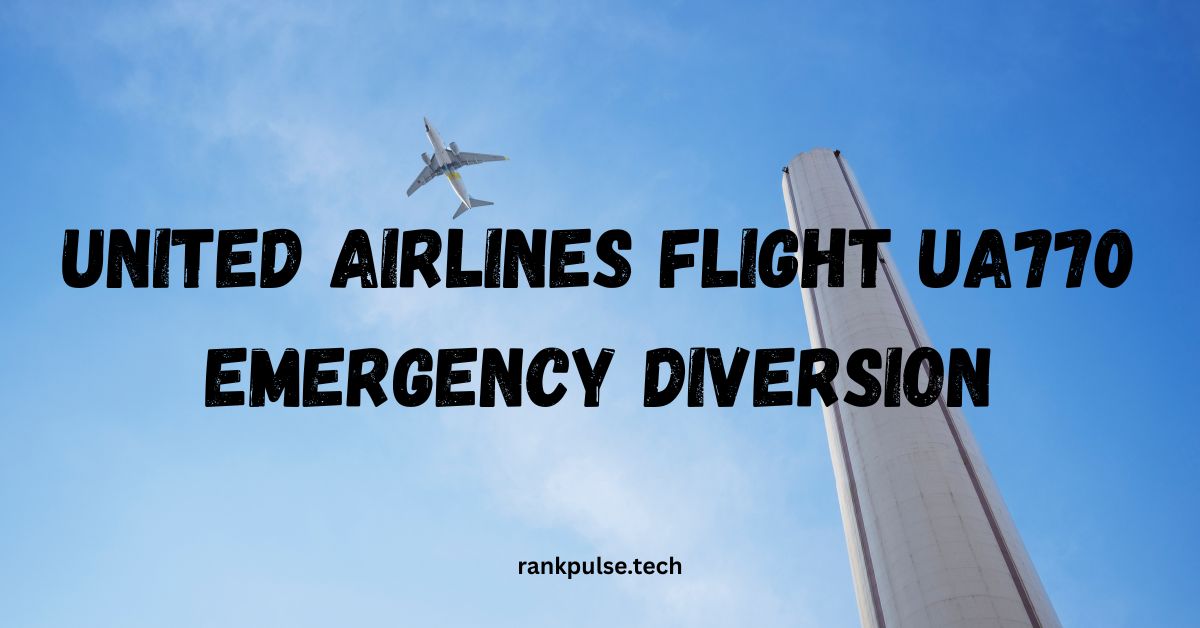United Airlines Flight UA770 Emergency Diversion: What Really Happened?
On May 27, 2025, the aviation world turned its eyes to a major safety event involving the emergency diversion of United Airlines Flight UA770. The flight, a Boeing 787-9 Dreamliner traveling from Barcelona to Chicago O’Hare, declared a mid-air emergency over the Atlantic. Pilots squawked code 7700, the universal distress signal, before diverting the aircraft to London Heathrow. Although cabin pressurization issues were suspected, the situation was handled with professionalism. This incident has since sparked global discussions about flight safety, passenger security, and how airlines respond during unexpected emergencies.
Details of United Airlines Flight UA770
The United Airlines Flight UA770 emergency diversion occurred while carrying around 257 passengers and 12 crew members. Initially scheduled for Chicago O’Hare, the flight encountered technical issues within the first 90 minutes of departure. Crew members quickly acted upon unusual pressurization readings, following safety guidelines. Passengers were informed calmly, preventing panic. The decision to divert to Heathrow ensured immediate access to medical and technical resources. By the time the Dreamliner touched down on Runway 27R, emergency vehicles were already in position, highlighting the flawless coordination between the airline, air traffic control, and ground support teams.
Reason Behind the Diversion
Reports indicate the United Airlines Flight UA770 emergency diversion was caused by a cabin pressurization issue. Modern aircraft like the Boeing 787 are equipped with monitoring systems that alert pilots of irregularities. A pressurization problem, if left unchecked, can cause discomfort, oxygen deprivation, and health risks for passengers and crew. The decision to squawk 7700 and divert was a precautionary measure rather than a response to immediate danger. This swift action ensured passenger safety remained the highest priority. The incident serves as a reminder of how aviation safety systems work to prevent small issues from escalating.
Summary Table
| Aspect | Details |
| Route | Barcelona → Chicago O’Hare |
| Aircraft | Boeing 787-9 Dreamliner (N26902) |
| Emergency Type | Cabin pressurization issue (suspected) |
| Squawk Code | 7700 (General Emergency) |
| Diversion Airport | London Heathrow, Runway 27R → Gate B44 |
| Outcome | Safe landing, no injuries, professional execution |
| Significance | Highlights aviation safety protocols and crew preparedness |
The Role of Pilots and Cabin Crew
During the United Airlines Flight UA770 emergency diversion, the professionalism of the crew played a critical role. Pilots promptly declared an emergency and coordinated with EUROCONTROL and Heathrow air traffic controllers for a smooth diversion. Inside the cabin, flight attendants reassured passengers, giving clear instructions while maintaining calm. Their training allowed them to handle potential fears while monitoring passenger health. This human element of aviation safety is often overlooked, yet it was vital in this situation. The crew’s calm communication and swift response helped avoid panic, turning a tense situation into a well-managed emergency landing.
Safe Landing at London Heathrow
The United Airlines Flight UA770 emergency diversion ended safely at London Heathrow Airport. Upon arrival, the Dreamliner landed smoothly on Runway 27R and taxied to Gate B44. Emergency services, including fire trucks and medical teams, stood ready but were not needed as no injuries were reported. Passengers were later accommodated as United Airlines worked to resolve technical checks and rebook connections. The flawless coordination between air traffic controllers, Heathrow ground staff, and United Airlines showcased how the aviation industry is prepared to deal with mid-air emergencies without disrupting safety or security.
Impact on Aviation Safety Awareness
The United Airlines Flight UA770 emergency diversion demonstrates why air travel remains one of the safest modes of transportation. Emergencies like pressurization issues are rare, but when they occur, airlines have strict protocols to ensure protection. Incidents like UA770 also educate the public about squawk codes, crew readiness, and airport emergency procedures. Instead of sparking fear, the event reassures travelers that commercial aviation prioritizes their well-being above everything else. By learning from such events, the aviation industry continues to refine its safety measures and boost passenger confidence in long-haul international travel.
Conclusion
The United Airlines Flight UA770 emergency diversion was a textbook example of aviation safety at work. From the moment the cabin pressurization issue was detected, to the decision to squawk 7700, to the safe landing at Heathrow, every action was handled with precision. The incident reinforces trust in air travel, showing that pilots, cabin crew, and ground staff are trained to protect passengers during emergencies. While technical malfunctions may occur, the aviation system is designed to prioritize human lives first. Ultimately, this event will be remembered not as a disaster, but as a victory for aviation safety.
FAQs about United Airlines Flight UA770 Emergency Diversion
Q: What caused United Airlines Flight UA770 to divert?
The United Airlines Flight UA770 emergency diversion was reportedly caused by a cabin pressurization issue, leading to a precautionary emergency landing.
Q: Where did the flight land after diversion?
The Dreamliner was diverted to London Heathrow Airport, where it landed safely on Runway 27R.
Q: Were there any injuries reported?
No injuries were reported during the United Airlines Flight UA770 emergency diversion. Passengers and crew remained safe throughout.
Q: How many people were on board?
There were approximately 257 passengers and 12 crew members on the flight at the time of the emergency.
Q: Why is the incident important for aviation?
The United Airlines Flight UA770 emergency diversion highlights how safety protocols, crew training, and technical systems work together to ensure passenger security during emergencies.


